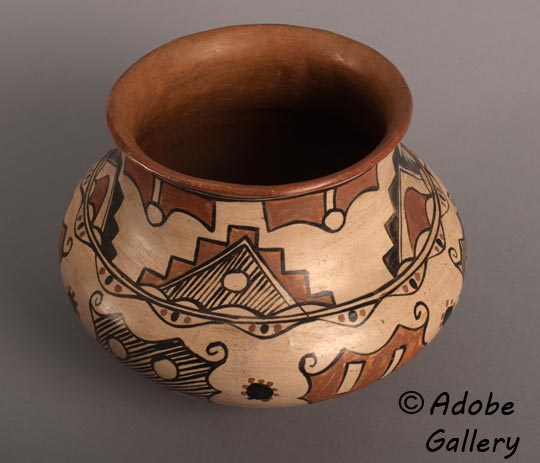Stunning 19th-century San Ildefonso Polychrome Jar by Maria [SOLD]
+ Add to my watchlist Forward to Friend
- Category: Historic
- Origin: San Ildefonso Pueblo, Po-woh-ge-oweenge
- Medium: clay, pigments
- Size: 8-½” Height x 11” Diameter
- Item # C4930E SOLD
This exquisite jar features that absolutely stunning 19th-century Tewa vessel shape, with a large mid-body ring or bulge that provided a secure handhold when the jar was carried on the head while walking. This shape, slightly modified over time, had existed for 500 years. The recent modification consisted of shortening the neck of the vessel from earlier versions that had long, graceful necks and lower centers of gravity.
The jar was most likely made around 1910. According to Jonathan Batkin, "several modifications occurred between 1895 and 1910." During that period, some potters began abandoning the use of red slip on the rim and switched to black. Since all potters probably did not make this change at the same time, there could be some jars with red slip on the rim that were made post-1910. This jar does have a red-slipped rim.
Another acceptable change occurred around 1905. Martina Vigil (1856-1916) and Florentino Montoya (1858-1918), who were frequent visitors to Cochiti Pueblo, discovered the bentonite slip being used by Cochiti potters, which did not require stone polishing but could be rag-wiped onto the pottery. They brought this knowledge back to San Ildefonso, and potters adopted its use. It was a major time saver for them. Some potters continued using the traditional San Ildefonso slip for a decade or two longer, but most switched immediately.
Maria Martinez is known to have made vessels of this shape. There are a number of published jars of this shape that are identified as being made by Maria. If the jar dates to circa 1910, then Maria would have been 23 years old and certainly very capable of making a vessel of this quality. Maria stated that her older sister Maximiliana (Anna) painted some of her pottery when the men were busy in the fields. Also, Crescencio, Anna's husband, is known to have painted some of Maria's pottery as well. So did Julian. Julian was an expert painter, as was Crescencio. Anna apparently was not as skilled in painting. The quality of the painting on this jar is exceptional and appears to be on par with the work of Julian or Crescencio. Each red design element was beautifully and precisely outlined in black pigment. The neck design elements are of two shapes: pendant from a rim framing line and resting on a shoulder framing line. The use of different colors in similar designs cleverly makes each shape unique. The mid-body designs differ in coloration, making similar-looking shapes appear distinct and individual.
If we accept the date of circa 1910 for this jar — near the end of the period of red-slipped rims — and accept that it is a favored vessel shape associated with Maria Martinez, then it is not unreasonable to attribute the jar to the hands of Maria. Who painted it? It appears to be more in line with the quality of painting done by Julian. Attributing the creation of the jar to Maria and the painting to Julian is a reasonable conclusion. For this reason, we are attributing this jar to Maria Martinez.
Condition: excellent condition
Provenance: This Stunning 19th-century San Ildefonso Polychrome Jar by Maria was originally purchased from Adobe Gallery in 2007 and now is being offered through the estate of an Adobe Gallery client.
Reference and Recommended Reading:
- Two Hundred Years of Historic Pueblo Pottery: The Gallegos Collection by Francis H. Harlow
- The Legacy of Maria Poveka Martinez by Richard L. Spivey.
TAGS: Pueblo Pottery, San Ildefonso Pueblo, Popovi Da, Santana and Adam Martinez, Julian Martinez, Maria Martinez, San Ildefonso Pueblo Potter

- Category: Historic
- Origin: San Ildefonso Pueblo, Po-woh-ge-oweenge
- Medium: clay, pigments
- Size: 8-½” Height x 11” Diameter
- Item # C4930E SOLD
Adobe Gallery Recommended Reading
Adobe Gallery Recommended Items
If you are interested in this item, we would also like to recommend these other related items:



